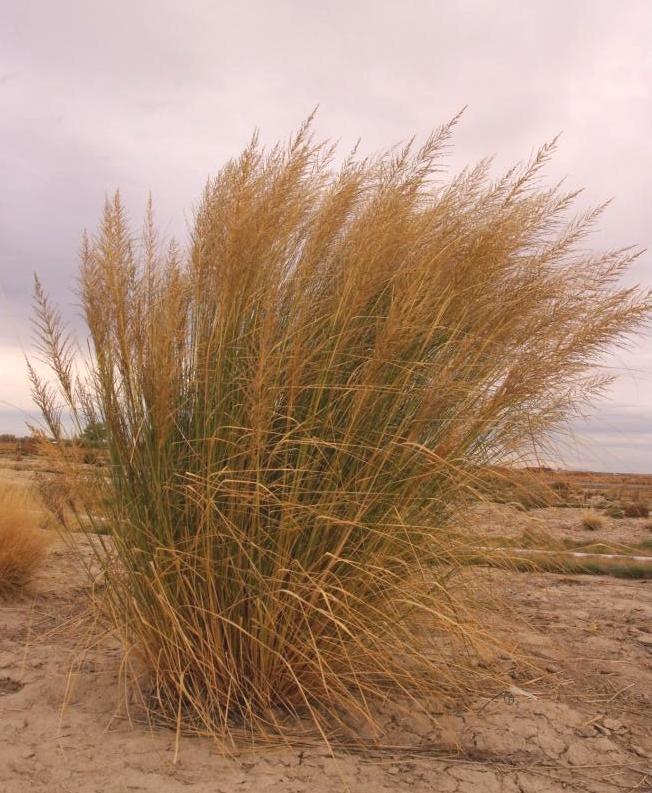Giant Sacaton in the Landscape

Stephen Love, University of Idaho
Scientfic Name: Sporobolus wrightiiCommon Name: Giant Sacaton, Big Sacaton
Description: Giant sacaton is tall, full, very long-lived ornamental grass and makes a superior dominant specimen in the landscape. A warm season grass, it is slow to green up in the spring but develops rapidly once temperatures warm. By midsummer, it will grow to a height of 7 to 8 feet. The leaves are narrow, fibrous, and form an open clump. The seed spikes are open, graceful, and glisten in sunlight. They remain attractive through the fall and winter months, adding landscape value to this plant. Giant sacaton thrives under xeric or irrigated conditions, making it easy to use in a variety of landscape applications. In addition to use as a specimen, the species makes a great screen plant.
Native Habitat: Sporobolus wrightii is native to the southwestern states and Mexico where it inhabits desert floodplains. Found at elevations ranging from 2,000 to 7,000 feet.
Cultural Requirement
Soil: Tolerates most soil types, including those with high pH. Can withstand soils with poor drainage.
Moisture Tolerance: Considered xeric but may need supplemental water if conditions become extremely dry. Will tolerate heavily irrigated conditions typical of a traditional landscape.
Sun/Shade/Preference: Requires full sun.
Transplanting: High rates of survival during transplanting, both from pot to pot and from pot to garden. Plants rapidly develop to marketable size, tolerate pot culture, and retain acceptable appearance in pots up to 5-gallon size.
Propagation: Simple to propagate from seed. No seed pretreatments are required. Seed germinates quickly and at a high percentage. Can be easily moved when mature and easily propagated from crown cuttings or divisions.
Maintenance (pruning, fertilization, deadheading, division, irrigation, etc):
Minimal maintenance is required. Cut back to 4 to 6 inches in late fall or early spring and discard the old foliage. Apply bi-weekly or monthly supplemental irrigation to optimize appearance. Add a small amount of nitrogen fertilizer if plants decline in vigor.
Insect, disease, or other problems: Giant sacaton exhibits no significant insect or disease problems.
Landscape Value
Use in the Landscape:
Giant sacaton is a very versatile plant for either xeric or traditional landscapes. It is effective as a single specimen plant or in a mass planting. Closely spaced plants can contribute seasonal screening. Provides substance and texture to any tall mixed bed or border. Makes a good tall element for naturalized areas or meadows but also works well in formal landscapes.
Foliage: Foliage forms a graceful, open mound up to 4 feet tall. The leaves are light green, narrow, folded inward, and stiffly fibrous. Leaves persist throughout the summer and may be evergreen in warmer climates.
Timing: June-October
Fruit: Seed-containing scales are arranged in open panicles. Seeds are numerous within each inflorescence.
Form: Form changes with season, being mounded prior to bloom; plants in early bloom are upright and ultimately becoming fountain-shaped with age.
Texture: Coarse
Ultimate Size: Pre-bloom plants are typically 3 to 4 feet tall and up to 4 feet wide. Plants in seed can be 8 feet tall (occasionally taller) with similar spread.
Rate of Growth:
Giant sacaton plants grow at a moderate rate and when spring-planted are often over 4 feet tall at the end of the first summer. They consistently bloom the first year in pots or after transplanting to the garden, although the flowering stalks may be somewhat sparse on young plants.
Suggested Plant Partners:
Giant sacaton can be mass planted as a monoculture or successfully arranged with a wide array of partners, including trees, shrubs, and tall or short perennials. Recommended partners include Celtis reticulata, Amorpha nana, Chamaebatiaria millefolium, Juniperus horizontalis, Linum lewisii, Penstemon barbatus, Penstemon cardinalis, Penstemon subglaber, Zinnia grandiflora, and Festuca idahoensis
Availability: Fairly easy to find potted plants at local or mail-order native plant nurseries. Seed can be purchased from native plant seed suppliers.
Cultivars: The large statured cultivar ‘Windbreaker’ is commonly available.
References:
Colorado State University. Sporobolus wrightii – Sacaton Grass. http://www.colostate.edu/Depts/CoopExt/4DMG/Lawns/orna2.htm. Accessed 26 Oct 2013.
- http://www.gardenguides.com/taxonomy/big-sacaton-sporobolus-wrightii/. Accessed 26 Oct 2013.
- http://en.hortipedia.com/wiki/Sporobolus_wrightii. Accessed 26 Oct 2013.

